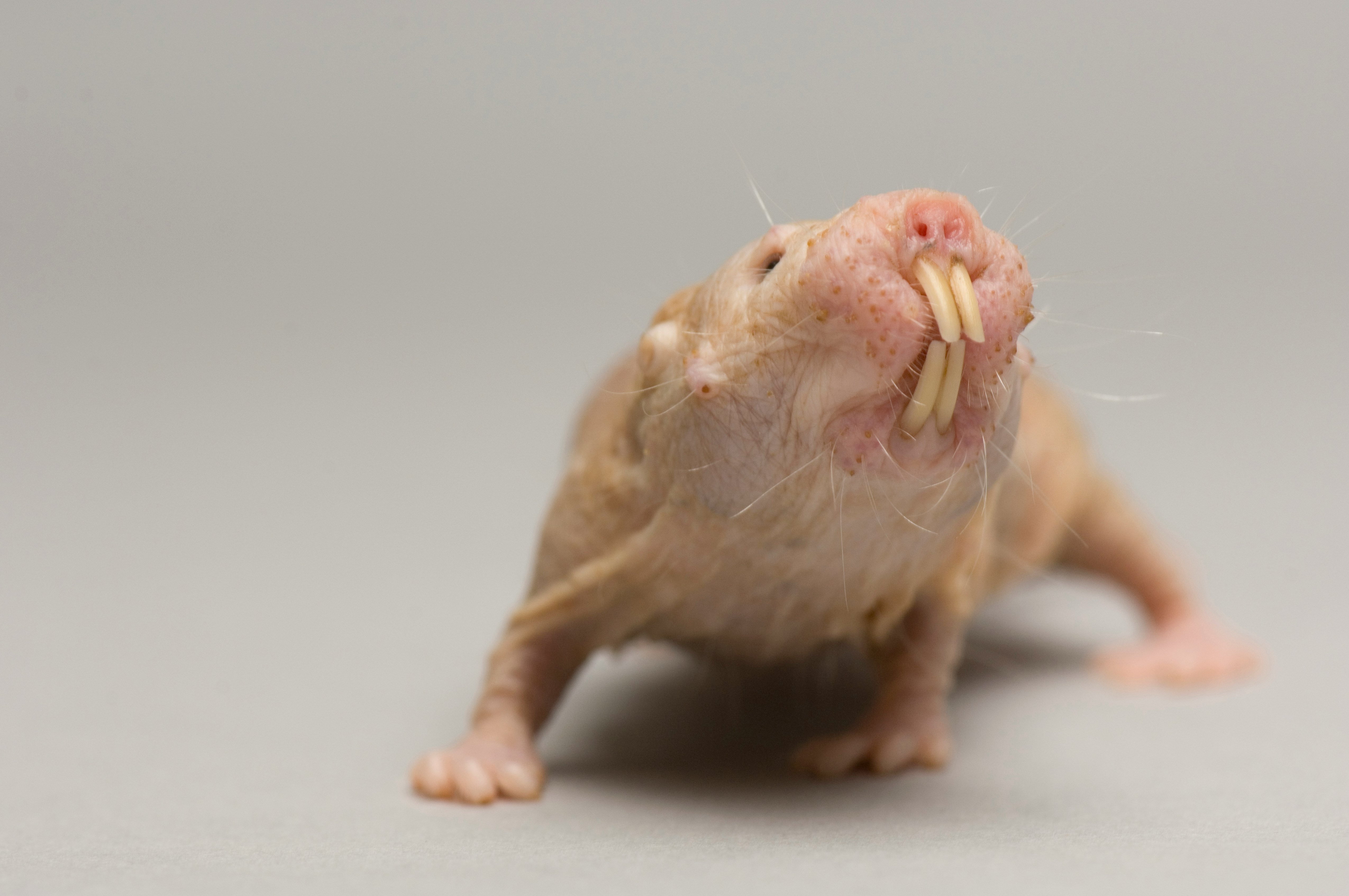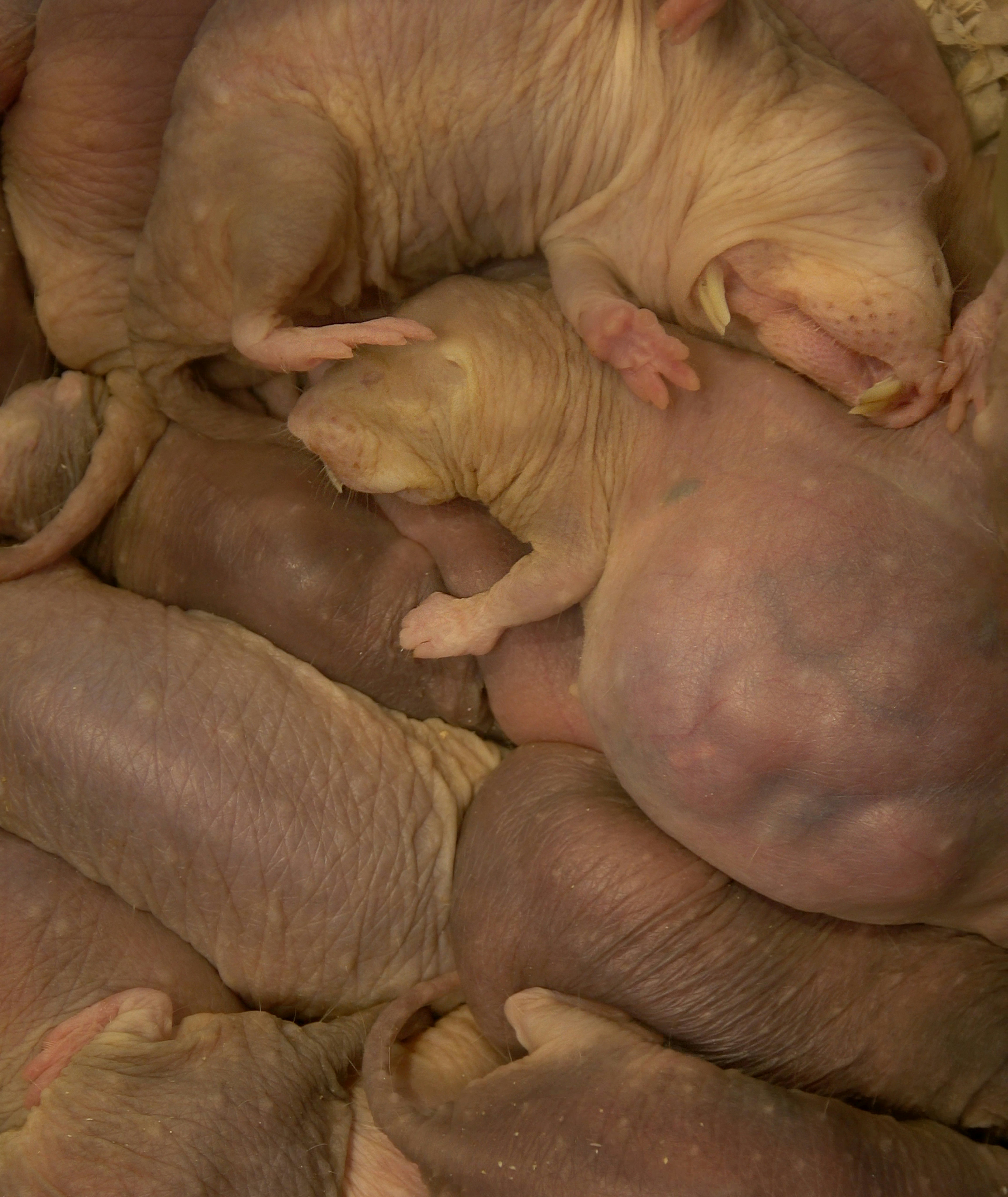
Your instinct might be to recoil from the fleshy naked mole-rat, but that would be a big mistake. These rodents, also known as "sand puppies," are scientifically fascinating: They're the only mammals who spend their entire lives in their colonies (like honeybees), they eat each other's poop, and they insist on heaping themselves into massive piles of long-toothed, hairless bodies.
According to new research, this weird propensity for piling up is actually linked to an important health benefit. It keeps the species safe, calm, and seizure-free. A genetic mutation underlies this need to stay close to one another — and a better understanding of this mutation could lead to better treatments for humans with neurological disorders.
This finding was published Thursday in the journal Current Biology.
The tendency of naked mole-rats, Heterocephalus glaber, to pile upon one another helps regulate their brain's chemistry, the study finds. When these rodents layer up in large groups to sleep in their nest, the air contains lower levels of oxygen and higher levels of carbon dioxide.
That's beneficial to the naked mole-rat because they have a genetic variant, called R952H, which causes them to panic and seizure if they encounter uninhibited levels of oxygen.
Piling up — After years of studying groups of mole-rats, researchers couldn't get past the fact that these strange mammals inexplicably loved a good pile, says co-author Dan McCloskey, an associate professor at the College of Staten Island.
"It seemed that no matter what we did to provide enrichment or comfort around their housing environment, they preferred to be piled on top of one another in a single cage," McCloskey tells Inverse. "It was like building a luxury resort and having all of the guests choose to sleep in the same broom closet!"
Now, McCloskey and his team think the desire to hang out in heaps is a response to a common genetic variation in naked mole-rats — the R952H variant. This is a mutation of the gene for the KCC2 protein, which normally helps regulate neurons. In turn, its existence makes it more difficult for naked mole-rats to suppress brain activity. When oxygen is flowing freely, their brains race — dangerously so.
Tightly packed nests mean higher levels of carbon dioxide and lower levels of oxygen, which inhibits naked mole-rat brain activity, and calms them.
McCloskey learned that, by piling up, the rodents were actually "covering up a vulnerability" and "taking advantage of the natural effects of carbon dioxide to reduce brain activity."

A human connection — That process of self-soothing may give researchers insight into humans with certain neurological conditions. The R952H variant is also reported in people with conditions like epilepsy, schizophrenia, and autism. Because all mammals have the KCC2 protein, including humans, it's also possible that members of the general population have this variant as well, McCloskey explains.
This finding suggests that some people may be more sensitive to air and certain ways of breathing — much like the naked mole-rats. It's also possible that, in the far future, the animal could be used to find better treatments for people with this genetic difference.
McCloskey and his team also pose a curious question about whether humans are already making lifestyle choices that mimic the effects of mole-rat pile-ups, based on their genetic differences.
"Naked mole-rats compensate by changing their breathing and choosing more stuffy environments," McCloskey says. "It is interesting to consider whether those of us who have this change do similar things."
It's increasingly clear that naked mole-rats have much to teach scientists: They also have a molecule that makes them pretty much cancer-proof. They can outlive all other rodents, clocking up to 30 years. And they're strangely fastidious when it comes to cleaning their underground colonies. Naked mole rats are also the only mammal species that live in eusocial colonies ruled by a queen, who is the only female who breeds.
The new research offers some clues as to why that eusociality works out for naked mole-rats.
"If these two species [of naked mole-rats] have a requirement for elevated carbon dioxide they will prefer to return to the colony nest rather than venture above ground and start a new colony," McCloskey explains.
The genetic mutation examined in this study might, in turn, be one of the genes that make eusociality an advantage. And while humans are far from this kind of colony living, this finding shows we may have more in common with our friends the mole-rats than you may like to think.
Abstract: African naked mole-rats were likely the first mammals to evolve eusociality, and thus required adaptations to conserve energy and tolerate the low oxygen and high carbon dioxide of a densely populated fossorial nest. As hypercapnia is known to suppress neuronal activity, we studied whether naked mole-rats might demonstrate energy savings in GABAergic inhibition. Using whole-colony behavioral monitoring of captive naked mole-rats, we found a consistent hypercapnic colony nest where all colony members spent the majority of their time. Analysis of the naked mole-rat genome revealed, uniquely among mammals, a histidine point variation in the neuronal potassium chloride cotransporter 2 (KCC2). A histidine missense substitution mutation at this locus in the human ortholog of KCC2, found previously in patients with febrile seizures and epilepsy, has been demonstrated to diminish neuronal chloride extrusion capacity, and thus impairs GABAergic inhibition. Seizures were observed, without pharmacological intervention, in adult naked mole-rats exposed to a simulated hyperthermic surface environment, causing hypocapnia. Consistent with the diminished function of KCC2, naked mole-rats demonstrate a reduced efficacy of inhibition that, remarkably, manifests as the triggering of seizures in adult naked mole-rats at room temperature by the GABAergic positive allosteric modulator diazepam. These seizures are blocked in the presence of nest-like levels of CO2 and likely to be mediated through GABAA receptor activity, based on in vitro recordings. These findings add altered GABAergic inhibition to a growing list of adaptations in the naked mole-rat and provide a plausible proximate mechanism for nesting behavior, where a return to the colony nest restores GABA-mediated inhibition.







